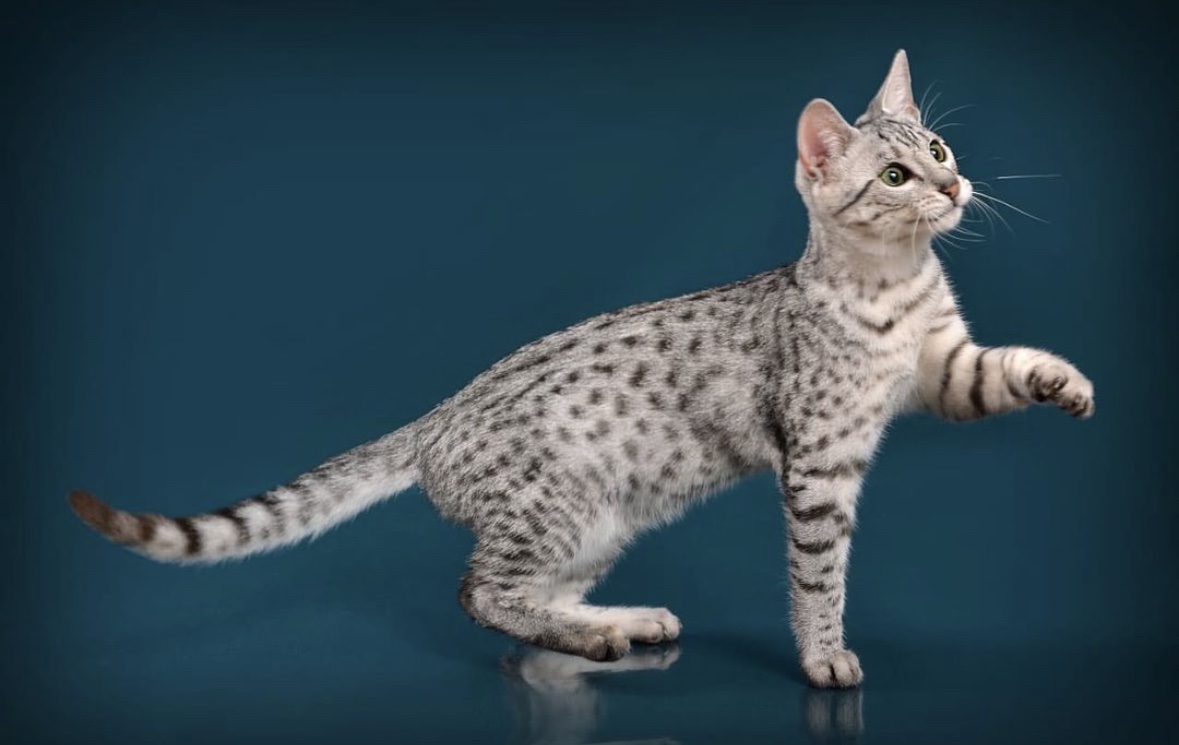History of Egyptian Maus
The history of the Egyptian Mau is like a cat’s tale filled with twists and turns. Meow-ver the fact that it’s often considered an ancient breed, its origin story is more complicated than you might think. These modern Egyptian Maus have some intriguing ancestors. They can trace their lineage back to kitties imported from the Middle East and got their fine-tuning in Europe, just like a gourmet meal.
If you go back in time over 3000 years, you’d find paintings of Egyptian Maus in ancient Egyptian art. These cats were not just pretty faces; they were trained to be expert bird hunters and retrievers. Now, hold your purrs because there’s a twist – even though people say the Egyptians worshiped cats, they didn’t always treat them like royalty. In some temples, cats were actually mass-produced to be sacrificed and mummified as offerings. Not exactly the pampered life, right?
When archaeologists unwrapped some ancient cat mummies from around 1000 BC, they found spotted tabby patterns. This shows that spotted domestic cats were quite common in ancient Egypt. But, here’s the rub: often, only the skin survived, not the fur itself. So, we can’t be absolutely paws-itive about all the details.
The Romans got in on the cat action too. They probably took some spotted cats from Egypt back to Italy during their reign. Spotted cats even made it into Roman mosaics, like a feline version of ancient art!
Now, for a bit of cat-linguistics: “Mau” is like Middle Egyptian for “cat.” So, when you say “Egyptian Mau,” you’re basically saying “Egyptian Cat” – quite the purr-fect name!
But after World War II, things got a bit chaotic for these fabulous felines. Fancy cats were in high demand again, and the native Egyptian Maus started mixing with stray cats, losing their unique identity. The same thing still happens in many places today because Siamese, Persians, and other fancy breeds are all the rage. In Egypt, they just called them “maus.” Some claim that Egyptian Maus are the only naturally occurring spotted cats, but that’s just a myth. They share that title with the Bahraini Dilmun cat.
Reney’s Egyptian Shorthair Cat, which sounds like the cat version of a Hollywood superstar, was being bred in France, Italy, and Switzerland in the early 20th century. It’s like the cat version of a gourmet dish, featuring slender European cats that stood tall on delicate legs and had ears that weren’t too wide. The cats were velvety, but not rough, and came in plain, smoked, patched, and tortoiseshell, as long as there were no patterns. Talk about a cat with class!
Now, let’s talk about Princess Nathalie Troubetskoy, who played a leading role in the Egyptian Mau’s journey. She had quite the adventure in Europe and the USA. In Italy, she started her own cat breeding program with some cats imported from Egypt. Her early Maus were born in the ’50s and quickly became the talk of the town in Europe.
In 1956, Princess Nathalie Troubetskoy moved to the USA, bringing three Egyptian Maus with her, two silver females, Fatima Baba and Liza, and Baba’s bronze son, Fatima Jojo. These cats formed the foundation for her cattery, aptly named Fatima. Liza, the third cat, didn’t seem to get in on the breeding action. The New York Daily News even reported their arrival, calling them “impressive creatures.” Imagine the excitement!
In 1957, an Egyptian Mau made its debut at the Boston Cat Show, attracting quite a crowd. They described Princess Nathalie Troubetskoy as a “well-known magazine writer and cat fancier.” Those early Egyptian Maus were like the cat celebrities of their time!
And let’s not forget the blue-eyed Egyptian Maus. They’re kind of like the rare jewels of the cat world. Some of these beauties had stunning blue eyes and came from different parents. The blue eyes were all the rage, but they were a result of the extensive inbreeding necessary to preserve the breed’s purity. It’s like a cat version of the blue-eyed blues!
The Egyptian Mau’s path to recognition was anything but straightforward. Some organizations recognized it as early as 1968, while others, like TICA, took their time, giving their official nod in 1979. In the UK, these feline gems arrived in the late ’90s and achieved recognition in 2004. They’re still pretty rare in the UK and continental Europe.
In Britain, the quarantine restrictions meant they had to recreate the Egyptian Mau using Abyssinians and Siamese, which is like trying to recreate a famous painting using a different color palette. This breed was eventually renamed the Oriental Spotted, so as not to be confused with the American breed.
Melissa Bateson was the brave soul who introduced the first true Egyptian Mau to the UK in 1998. She started with three silver females and a silver male, and the rest is history. Egyptian Maus in the UK come from the original lines, Indian lines, and the “new Egyptian lines.” They don’t allow outcrossing to other breeds, so the gene pool is what it is.
There’s even some genetic detective work going on! DNA analysis has shown that Egyptian Maus might look like ancient Egyptian cats but actually have a lot of European influence in their bloodlines. They seem to be more closely related to cats from Turkey and Tunisia than to cats from Egypt. Genetic studies grouped them with breeds like Siamese, Russian Blue, Korat, and Abyssinian. So those blue-eyed Egyptian Maus? They could be due to outcrossing with Russian Blues or Korats. The mysteries of genetics, eh?
So, there you have it, the intriguing and sometimes meow-dern history of the Egyptian Mau, a breed with more tales to tell than the fanciest of felines! 🐾😺

